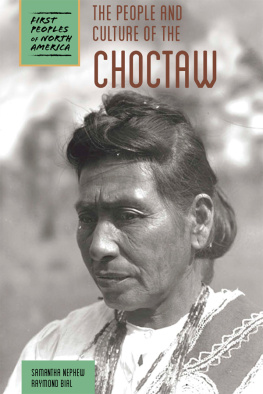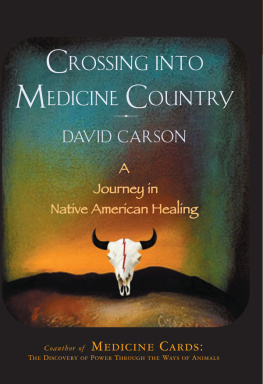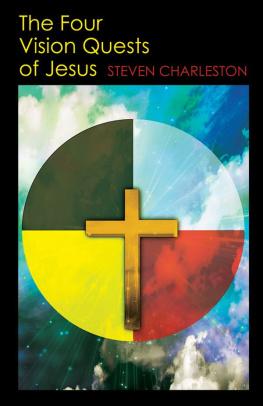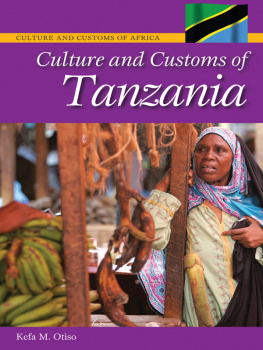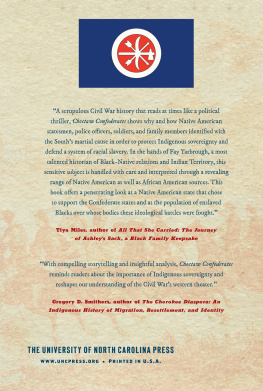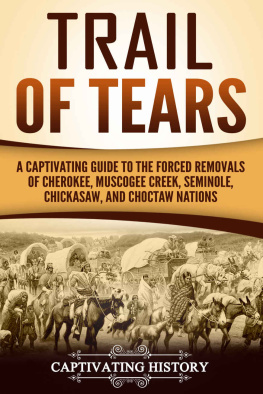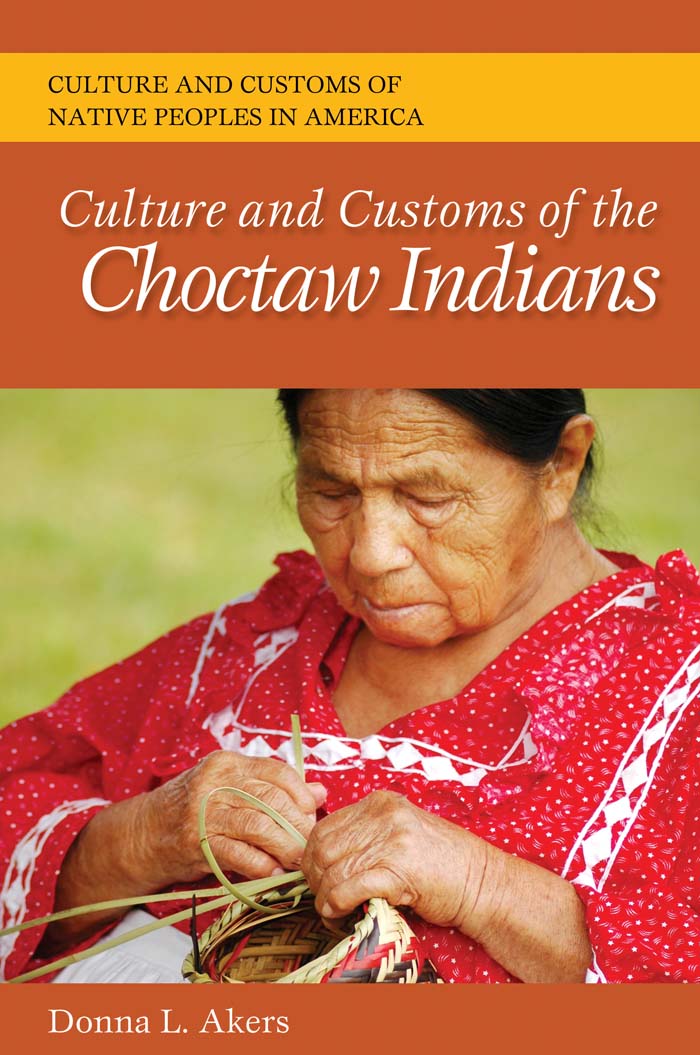Culture and Customs
of the Choctaw Indians
Culture and Customs
of the Choctaw Indians
DONNA L. AKERS, PH.D.
Culture and Customs of Native Peoples in America
Tom Holm, Series Editor

Copyright 2013 by Donna L. Akers
All rights reserved. No part of this publication may be reproduced, stored in a retrieval system, or transmitted, in any form or by any means, electronic, mechanical, photocopying, recording, or otherwise, except for the inclusion of brief quotations in a review, without prior permission in writing from the publisher.
Library of Congress Cataloging-in-Publication Data
Akers, Donna.
Culture and customs of the Choctaw indians / Donna L. Akers.
p. cm.
Includes bibliographical references and index.
ISBN 978-0-313-36401-3 (hardcopy : alk. paper) ISBN 978-0-313-36402-0 (ebook)
1.Choctaw IndiansHistory.2.Choctaw IndiansSocial life and customs.I.Title.
E99.C8A42 2013
976.004'97387dc23 2012032912
ISBN: 978-0-313-36401-3
EISBN: 978-0-313-36402-0
17 16 15 14 13 1 2 3 4 5
This book is also available on the World Wide Web as an eBook.
Visit www.abc-clio.com for details.
Greenwood
An Imprint of ABC-CLIO, LLC
ABC-CLIO, LLC
130 Cremona Drive, P.O. Box 1911
Santa Barbara, California 93116-1911
This book is printed on acid-free paper
Manufactured in the United States of America
Contents
Series Foreword
Since the 1960s, native and nonnative scholars have diligently sought to disassemble and understand the false and, frankly, harmful stereotypes and images of Native American peoples. Many Americans have recognized that stereotypes of indigenous people are not only often wrong, but have actually fostered adverse political and legal decisions and even sporadic and arbitrary attempts to have whole Native American communities eradicated. The steep and steady decline of the indigenous population, the dissolution of native governments, and the loss of culture and lands stem from an almost perverse lack of knowledge about Native American peoples.
Despite the dispossession of lands and many, many cultural features, Native American peoples have been astonishingly resilient. White Earth Anishinaabe author Gerald Vizenor, a word craftsman of no mean abilities and talents, coined the term survivance from the words survival and resistance to capture the twofold nature of why indigenous customs and cultures are still alive. The Greenwood Press series Culture and Customs of Native Peoples in America attempts not to cast aspersions on the motives, desires, and policies of the Europeans and Euro-Americans who colonized North America, but to highlight, especially to young people and a general audience, the beauty, knowledge, pride, and resiliency of the indigenous peoples of this land. Survivance is very real. Native Americans, as our authors show, are not extinct; nor have they become a single, relatively small U.S. ethnic group.
Rather, Native Americans are here today as members of many indigenous nation-states that have utterly unique relationships with the United States.
Today, the federal government recognizes 562 American Indian and Native Alaskan tribes and communities that are self-governing and hold certain sovereign rights and powers. More than 1 million people are citizens or members of these nation-states. Nearly 4.5 million people in the United States claim some degree of American Indian or Alaska Native racial heritage.
Most Americans do not quite understand that Native American sovereignty relates specifically to the survival of tribal cultures. When the Europeans came to North American shores, there were hundreds of indigenous peoples, each group with its own territorial boundaries, distinct language, religious customs, and ceremonial cycles attuned to the place in which they lived, and a unique and sacred history. All had developed governing bodies that maintained order within and could raise military forces to protect and defend their territories. Each was, therefore, sovereign, but each had different forms of governance, whether by council, kingship, or priesthood. Nearly all of the native nation-states based their social organization on kinship.
The European colonists came for land and human and natural resources. At first, they attempted to displace the indigenous nation-states or enter into largely unequal and oftentimes destructive trade relationships. Very many Native Americans perished as a result of new, pandemic diseases that were endemic to European populations. Native nations were also caught up in a series of colonial wars that led to further depopulation.
In an effort to end violence and bring about stability, native nations entered into a series of treaties with foreign powers. When the United States emerged from the stew of colonialism, it continued the treaty-making policies in order to expand its eminent domain from coast to coast. Of course, numerous terrible wars resulted from this policy, but for the most part, native nations and the United States maintained the relationships they created in the treaty-making process. Native nations lost territory, and many were displaced from their homelands, but 562 of them have maintained what has been called limited sovereignty. What this means is that although native nation-states have certainly lost some of their powers as sovereigns, they have maintained the rights of taxation, territorial integrity, determination of citizenship, and cultural sovereignty. Despite the fact that the U.S. government has violated nearly every one of their treaties with the native nations, the treaties established todays general guarantee that native peoples can continue as autonomous cultural entities with the ability to change or adapt on their own terms. This is only one of the reasons that native peoples assert their sovereignty rather than simply become assimilated into the general U.S. society.
Another indigenous people, the Native Hawaiians, were treated similarly. The descendants of Native Hawaiians number more than 4 million people. Their own nation-state, established over all the islands by King Kamehameha the Great in 1810, was undermined and finally usurped in 1893. Queen Liliuokalani was actually imprisoned and replaced by a ruling cabal of businessmen and plantation owners. For a time, these men ruled the islands as the Republic of Hawaii. In 1898, the United States annexed the islands, and the territory eventually became a state of the union in 1959. Since then, Native Hawaiians have adapted their customs and culture to ensure their survival. Cultural traditions have multiplied and the native language has been preserved in place names, ceremonies, and in a number of households.
The Culture and Customs of Native Peoples in America series hopes to serve as an exploration of the vibrant cultures and intriguing customs of several North American indigenous groups, from religious practice and folklore to traditional costumes and cuisine. It is an enjoyable and stimulating journey.
Tom Holm
Tucson, Arizona
Preface
The history of the Choctaw people is thousands of years old. Long before Europeans crossed the Atlantic Ocean to North America, Choctaw people had lived for hundreds of generations in their ancient homelands. They passed down their ancient history from generation to generation, emphasizing the stories that taught about their belief system and the values they held dear. Children learned about the importance of kinship and the values of generosity and reciprocity and understood the place of humankind in the greater world of plants and animals, rocks, and streams. Tens of thousands of Choctaw people were born, came to adulthood, grew old, and died. Their world was not a New World, as the invading Europeans called it. It was a wise and beautiful land that had sustained millions of indigenous peoples for millennia.


